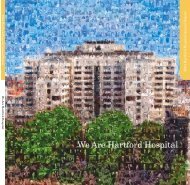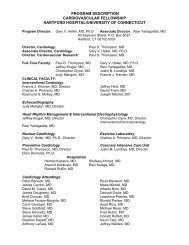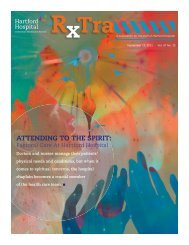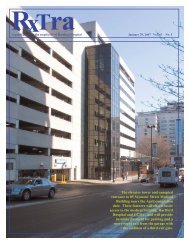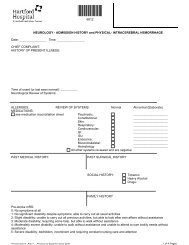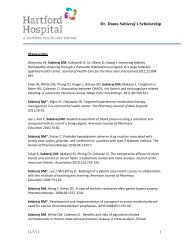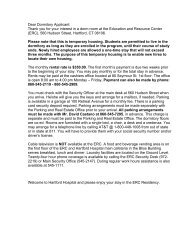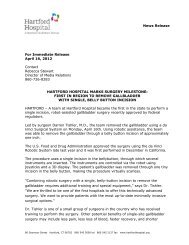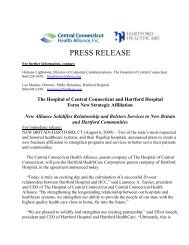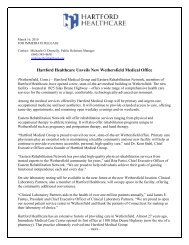Patient Safety Action Group (PSAG) Newsletter ... - Hartford Hospital!
Patient Safety Action Group (PSAG) Newsletter ... - Hartford Hospital!
Patient Safety Action Group (PSAG) Newsletter ... - Hartford Hospital!
You also want an ePaper? Increase the reach of your titles
YUMPU automatically turns print PDFs into web optimized ePapers that Google loves.
<strong>Patient</strong> <strong>Safety</strong><br />
<strong>Action</strong> <strong>Group</strong><br />
May 9, 2013<br />
Year 6; No. 19<br />
From the Graduate RN Residency <strong>Group</strong>:<br />
Do you know SNADD?<br />
Proper narcotic<br />
administration,<br />
documentation and<br />
disposal is critical.<br />
The following is provided by the<br />
Graduate RN Residency Performance<br />
Improvement <strong>Group</strong> (Christina Camp,<br />
Brittany Menta, Magdalys Ortiz,<br />
Rebecca McDonald, Sara Hills, and<br />
Shoushounova Dallas. )<br />
Do you know SNADD? It is an acronym<br />
for Safe Narcotic Administration,<br />
Documentation, and Disposal.<br />
<strong>Patient</strong> safety comes first, especially<br />
when it comes to medication<br />
administration.<br />
When administering narcotics,<br />
adherence to the Medication Orders<br />
and Administration Policy and<br />
Automated Dispensing Device (Pyxis)<br />
policy is mandatory. These policies<br />
are easily found on Alfresco.<br />
Key Concepts in Narcotic Administration:<br />
• All medication removal and<br />
administration must match patient’s<br />
orders and electronic medication<br />
administration record (EMAR).<br />
• Medication is to be administered<br />
within 30 minutes of withdrawal<br />
from Pyxis.<br />
• Two nurses are required to<br />
document waste of a controlled<br />
drug. The wasted medication is<br />
to be documented at the time the<br />
medication is wasted (within 30<br />
minutes of removal)<br />
• Controlled substances should be<br />
wasted in the following manner:<br />
tablets should be crushed; capsules<br />
emptied; transdermal patches folded<br />
and cut up; and vials emptied and<br />
expressed. All should be disposed<br />
of in the approved hazardous waste<br />
containers.<br />
• Lost medications require a Quantros<br />
Report, notification to pharmacy and<br />
to the nurse manager.<br />
• Controlled substance keys must be<br />
with RN at all times (IOL)<br />
Following these key concepts<br />
will maintain patient safety and<br />
compliance for all mandated state and<br />
federal regulations.<br />
Remember SNADD for best practice.<br />
The safety of our patients depends on<br />
you.<br />
Voices of<br />
Our <strong>Patient</strong>s<br />
Before my wife was<br />
moved to Palliative<br />
Care, she was a<br />
patient in the main<br />
part of the hospital<br />
where she was being<br />
treated for breast<br />
cancer.<br />
I recall one day near<br />
the end when I came<br />
to visit her, and as I<br />
was leaving, a nurse<br />
saw me. She reached<br />
out and gave me a<br />
hug of compassion<br />
and caring.<br />
That simple act of<br />
kindness has stayed<br />
with me all these<br />
years. I wish I could<br />
find that nurse and<br />
thank her. At the time<br />
I was too choked up<br />
with emotion to say<br />
anything.<br />
Anonymous<br />
Reprinted with permission
<strong>Patient</strong> <strong>Safety</strong> <strong>Action</strong> <strong>Group</strong><br />
Page 2 May 9, 2013<br />
Team of the Year Nominee:<br />
TEG Implementation Team<br />
In 2010, we<br />
acquired two TEG<br />
analyzers to use<br />
in the OR. The<br />
TEG analyzer<br />
provides doctors<br />
with immediate<br />
feedback<br />
regarding<br />
patients’ blood<br />
clotting status.<br />
This is especially<br />
critical right after<br />
removal from the<br />
heart-lung machine, when the patient<br />
is most prone to bleeding. (TEG stands<br />
for (Thromboelastograph.)<br />
Minimizing transfusions is safest<br />
for our patients. The use of TEG data<br />
allows for the absolute minimum<br />
amount of blood product to be given.<br />
It was determined that the<br />
Hematology Laboratory would be<br />
better suited to perform TEG testing,<br />
and a team was identified to begin<br />
plans for implementation. This was<br />
a coordinated effort between CLP<br />
Lab staff, hematopathologists,<br />
anesthesiology, perfusion and IT<br />
staff at both CLP and HH.<br />
TEG testing started for cardiovascular<br />
surgery cases. Every time a TEG test is<br />
performed, there needs to be closely<br />
coordinated communication between<br />
the OR and the lab staff because some<br />
TEG samples must be tested within<br />
four minutes of collection.<br />
A call is initiated to alert the lab that<br />
a TEG specimen is being drawn, the<br />
OR runners are in position to deliver<br />
it immediately to the Hematology Lab,<br />
and the lab technologist has entered<br />
basic demographic information in<br />
preparation for the sample.<br />
Prior to implementation of TEG<br />
testing, blood product utilization at<br />
<strong>Hartford</strong> <strong>Hospital</strong> was monitored for<br />
appropriateness in the OR, but less<br />
sensitive tests were used to assess<br />
need for blood products.<br />
Data collected since TEG testing began<br />
in July 2011 shows a 27.5% decrease<br />
in blood product utilization, with<br />
annualized savings of approximately<br />
$300,000 to date.<br />
We have improved patient safety,<br />
revised best practices in the OR<br />
using the TEG results, and provided<br />
cost savings to <strong>Hartford</strong> <strong>Hospital</strong>, all<br />
while promoting positive interactions<br />
between departments.<br />
Team members: Mike Acosta, Paul<br />
Altonji, Jennifer Bissonnette, Jordan<br />
Blinder, William Campeau, Allison<br />
Conelius, Denzil Copeland, Tina Dibble,<br />
Manny Escobar, Linda Freeman-Bosco,<br />
John Gary, Marbelia Gonzalez, Geoffrey<br />
Hayward, David Hull, Ken Jeleniowski,<br />
Thomas Martin, Thomas May, Leah<br />
Meisterling, Thomas Mort, Alberto<br />
Nieves, Rabi Panigrahi, Tim Phair, Enzo<br />
Pistritto, Birgit Randazzo, John Ravi,<br />
Ruben Rodriguez, Peter Shen, Bradford<br />
Sherburne, Jaime Spafford, Sengaroune<br />
Sundara, Sara Therrien, Nicole Tomasello,<br />
Witold Waberski.<br />
We want to hear from<br />
you. Just email us at<br />
psag@harthosp.org<br />
with your thoughts. If<br />
you do not have access<br />
to e-mail, you can<br />
send your comments<br />
or suggestions via the<br />
inter-hospital mail.<br />
Address the envelope<br />
to the <strong>Patient</strong> <strong>Safety</strong><br />
<strong>Action</strong> <strong>Group</strong>. (Please<br />
include your name<br />
and department if you<br />
would like a response<br />
from <strong>PSAG</strong>.) Useful<br />
ideas win awards!<br />
<strong>PSAG</strong> Meeting<br />
Location Reminder<br />
Monday, 5/13/13<br />
Special Dining Room<br />
Tuesday, 5/14/13<br />
JB-116<br />
Wednesday, 5/15/13<br />
Special Dining Room<br />
All meetings start at 7:30 a.m.<br />
All staff welcome to attend



